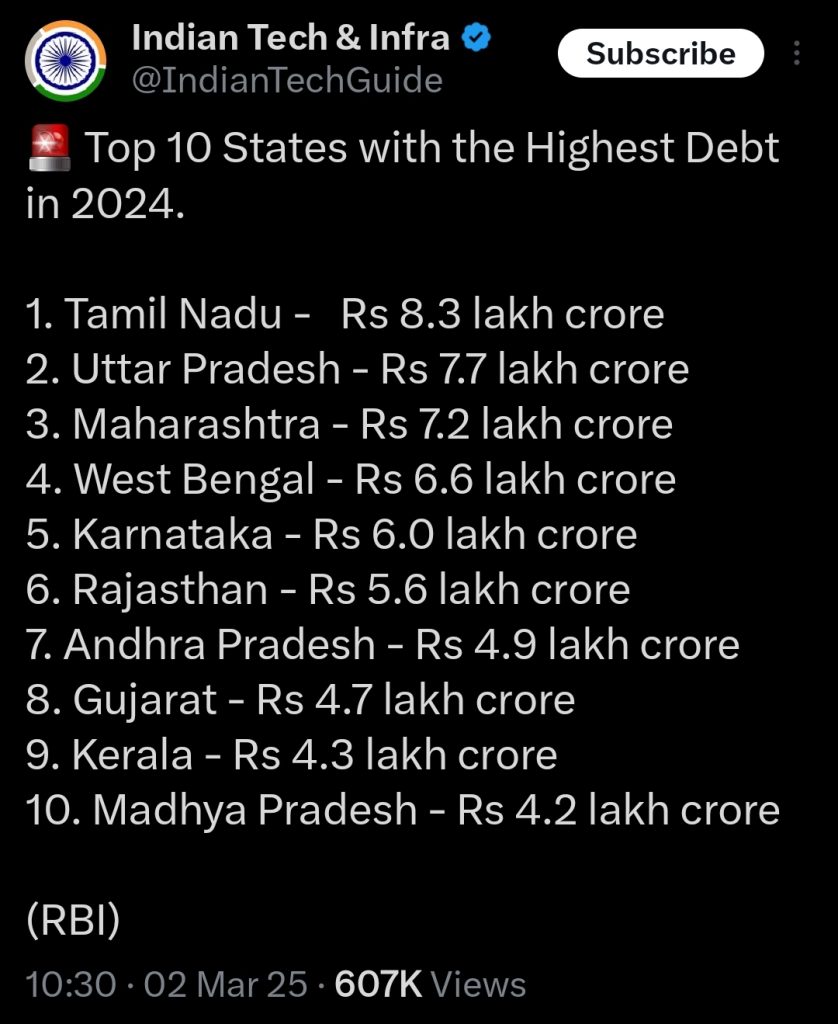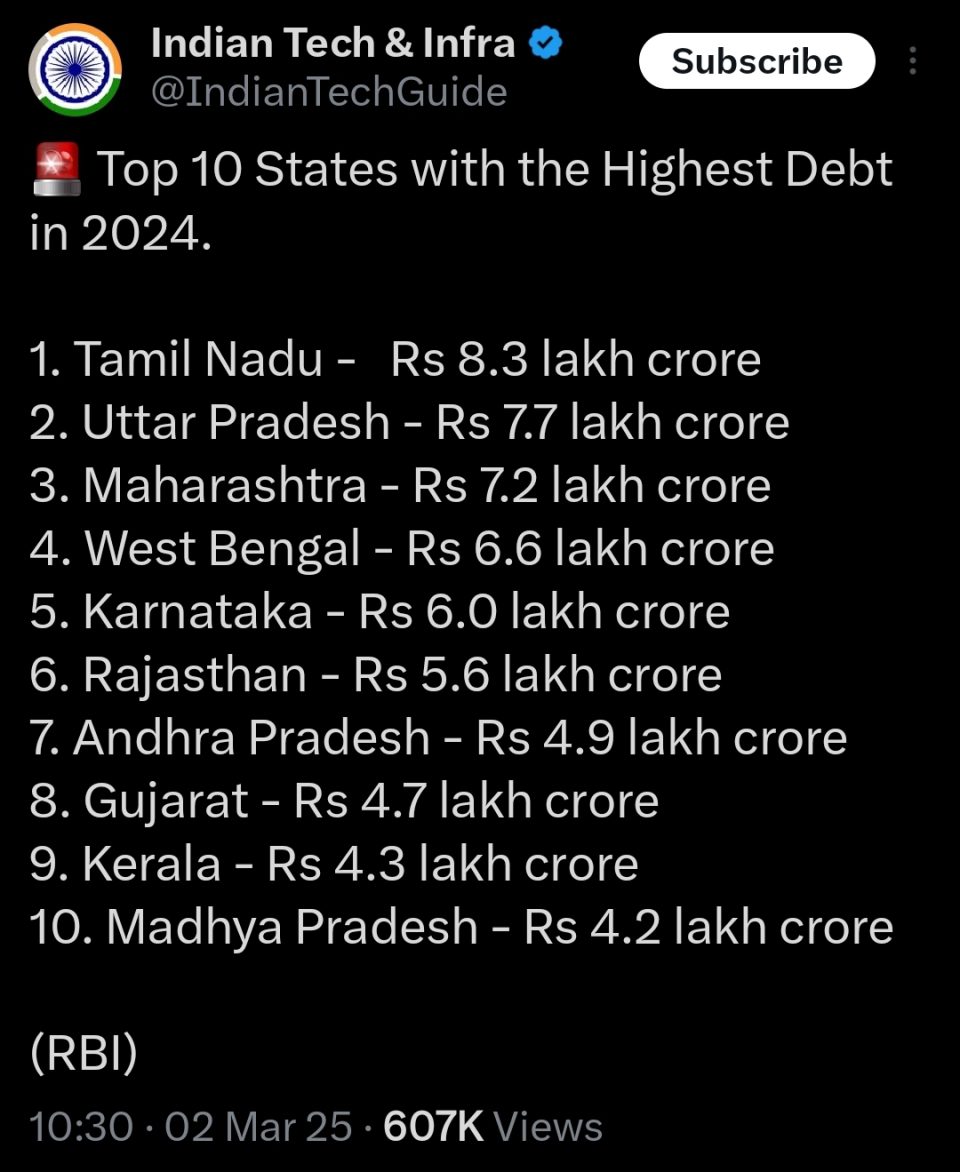State Debt and Citizen Experience: How Public Borrowing Shapes Daily Life
Debt levels impact more than just government balance sheets. They shape citizen experiences, public services, and business environments. High state debt can affect governance quality, service delivery, and economic stability. How do citizens feel the effects? Which states manage debt while ensuring good services? A closer look at India’s ten most indebted states reveals key trends in public experience.
Public Services and State Debt: The Citizen’s Burden
Public debt often leads to reduced spending on healthcare, education, and infrastructure. Citizens notice delayed projects, overcrowded hospitals, and poor roads. When debt rises, governments may increase taxes or reduce subsidies. Higher fuel prices, costly public transport, and increased tolls frustrate citizens. People expect efficient governance, but debt mismanagement leads to dissatisfaction.
Tamil Nadu: High State Debt, High Welfare
Tamil Nadu, with ₹8.3 lakh crore debt, balances welfare spending with economic growth. Citizens benefit from free public healthcare, subsidized transport, and social programs. However, borrowing strains the state’s financial stability. Large-scale infrastructure projects slow down due to fiscal limitations. Residents face issues like delayed road repairs and occasional power shortages.
Uttar Pradesh: Infrastructure Push with Fiscal Constraints
Uttar Pradesh’s ₹7.7 lakh crore debt comes from ambitious infrastructure projects. Expressways, metro expansions, and smart city developments improve citizen experiences. However, public hospitals remain overcrowded, and rural roads suffer from neglect. Increased state borrowing raises concerns about future taxation. Businesses worry about rising operational costs due to fiscal pressure.
Maharashtra: Balancing Growth with Rising State Debt
Maharashtra, with ₹7.2 lakh crore debt, remains India’s financial hub. Mumbai’s infrastructure receives significant investments, ensuring smoother urban mobility. Yet, debt levels put pressure on rural development. Farmers struggle with delayed subsidies, and water scarcity remains a challenge. Citizens appreciate metro expansions but expect more from public healthcare.
West Bengal: Economic Challenges and Service Gaps
West Bengal’s ₹6.6 lakh crore debt affects economic stability. The state spends heavily on salaries and pensions, reducing funds for development. Public transport remains affordable, but road conditions deteriorate. Job seekers migrate due to slow industrial growth. Businesses struggle with regulatory inefficiencies, affecting customer satisfaction.
Karnataka: Tech Boom vs. Fiscal Concerns
Karnataka, with ₹6.0 lakh crore debt, drives India’s tech sector. Bengaluru’s digital services improve citizen engagement. However, road congestion, rising living costs, and uneven development create dissatisfaction. Water supply issues in urban areas frustrate residents. Despite strong governance, high debt raises concerns about sustainability.
Rajasthan: Welfare Schemes vs. Financial Stress
Rajasthan’s ₹5.6 lakh crore debt funds pension schemes and social benefits. Citizens rely on these programs, but long-term sustainability remains uncertain. Infrastructure development slows due to financial constraints. Small businesses face challenges due to inconsistent state policies. Rural connectivity lags behind other states, impacting economic opportunities.
Andhra Pradesh: Investment Hurdles and Public Concerns
Andhra Pradesh, with ₹4.9 lakh crore debt, struggles to attract investors. Political instability affects citizen confidence. Public healthcare remains affordable, but medical facilities require upgrades. The state’s financial stress impacts business-friendly policies. Employment growth stagnates, leading to increased migration.
Gujarat: Industrial Growth Amid State Debt Management
Gujarat, with ₹4.7 lakh crore debt, prioritizes industrial expansion. Business-friendly policies attract investment, improving job prospects. Infrastructure projects boost economic growth, benefiting citizens. However, public healthcare and education need better funding. Urban development progresses faster than rural welfare programs.
Kerala: Strong Social Services Despite High State Debt
Kerala, with ₹4.3 lakh crore debt, maintains excellent public services. Healthcare and education rank among the best in India. Citizens enjoy high literacy rates and accessible medical facilities. However, revenue generation remains a challenge. Heavy borrowing could affect long-term sustainability.
Madhya Pradesh: Stable Growth with Fiscal Caution
Madhya Pradesh, with ₹4.2 lakh crore debt, balances borrowing with industrial expansion. Urban centers develop steadily, creating job opportunities. Public transport sees gradual improvement, benefiting daily commuters. Rural areas still need better connectivity. Citizens appreciate stable governance but demand faster reforms.
CX in Governance: How State Debt Shapes Public Perception
Public perception of governance depends on service efficiency. Citizens demand faster grievance resolution, digital accessibility, and corruption-free administration. High debt affects budget allocations, leading to slow decision-making and bureaucratic delays.
Tamil Nadu: Mixed Reactions to Debt-Driven Development
Citizens appreciate Tamil Nadu’s strong welfare programs but question long-term debt management. Digital governance improves efficiency, but infrastructure projects face delays. People demand better fiscal transparency.
Uttar Pradesh: Development vs. Bureaucratic Slowdowns
Public projects improve connectivity, yet rural citizens experience bureaucratic inefficiencies. Service delivery remains inconsistent, affecting public trust. Business owners seek faster policy reforms.
Maharashtra: Progressive Policies but Fiscal Challenges
Maharashtra’s governance earns praise for innovation, but debt creates concerns. Citizens support infrastructure expansion but expect better rural service accessibility. Businesses demand stronger fiscal discipline.
West Bengal: Political Instability Affects Public Confidence
Government programs help citizens, but debt-driven policies worry economists. Tax burdens increase, affecting business confidence. Public perception of governance remains divided.
Karnataka: Tech Leadership with Governance Challenges
Karnataka leads in digital governance, but urban congestion frustrates citizens. Businesses thrive, yet service delivery inconsistencies affect ease of living. People expect better waste management and water distribution.
Rajasthan: Pension Commitments vs. Economic Expectations
Rajasthan’s pension obligations limit economic flexibility. Citizens value social schemes but worry about financial sustainability. Public expectations for infrastructure improvements remain high.
Andhra Pradesh: Political Changes Impact Citizen Trust
Frequent leadership changes affect long-term planning. Citizens experience service disruptions. Business confidence fluctuates due to inconsistent policies.
Gujarat: Proactive Governance with Fiscal Caution
Gujarat maintains investor confidence despite debt concerns. Citizens experience stable governance, but rural areas demand better support. Business owners appreciate streamlined processes.
Kerala: High Welfare, Moderate Governance Challenges
Kerala’s welfare model benefits citizens, but fiscal sustainability remains a concern. Public trust in governance remains strong, yet economic diversification needs attention.
Madhya Pradesh: Gradual Reforms Improve Perception
Stable governance ensures steady development. Citizens appreciate progress but demand faster rural development initiatives. Business sentiment remains positive.
State Debt vs. Business Environment: The Ease of Living & Working
Businesses thrive where economic stability exists. High state debt affects credit ratings, discouraging investors. Infrastructure gaps, regulatory inefficiencies, and tax uncertainties create business hurdles.
- Tamil Nadu: Business confidence remains high, but infrastructure bottlenecks affect industrial growth.
- Uttar Pradesh: Improving connectivity boosts entrepreneurship, but bureaucratic hurdles slow approvals.
- Maharashtra: Mumbai’s financial dominance supports businesses, but high costs create challenges.
- West Bengal: Slow industrial expansion impacts business confidence, affecting employment opportunities.
- Karnataka: Startups thrive, but high living costs and urban congestion create challenges.
- Rajasthan: Businesses struggle with inconsistent policies and financial unpredictability.
- Andhra Pradesh: Investment prospects remain uncertain due to political instability.
- Gujarat: Industrial growth benefits businesses, but rural entrepreneurship needs support.
- Kerala: High literacy rates create a skilled workforce, yet revenue generation needs strengthening.
- Madhya Pradesh: Business-friendly policies improve confidence, but infrastructure gaps remain.
Balancing State Debt and Citizen Satisfaction
Some states manage debt wisely, ensuring better citizen experiences. Tamil Nadu’s social welfare schemes provide relief despite fiscal pressure. Maharashtra’s infrastructure investments support long-term growth.
Madhya Pradesh balances borrowing with industrial development. Efficient planning ensures steady employment and economic opportunities. Citizens appreciate stable job markets and quality services.
Governments must prioritize responsible borrowing, efficient spending, and transparent communication. Debt should not compromise public services or business growth. When states manage debt effectively, citizen satisfaction remains high.

Final Thoughts
State debt directly impacts citizen experience. From public services to governance quality, borrowing decisions affect daily life. Transparent policies, strategic investments, and efficient service delivery define public perception. Ultimately, good governance ensures financial stability while prioritizing citizen needs.

